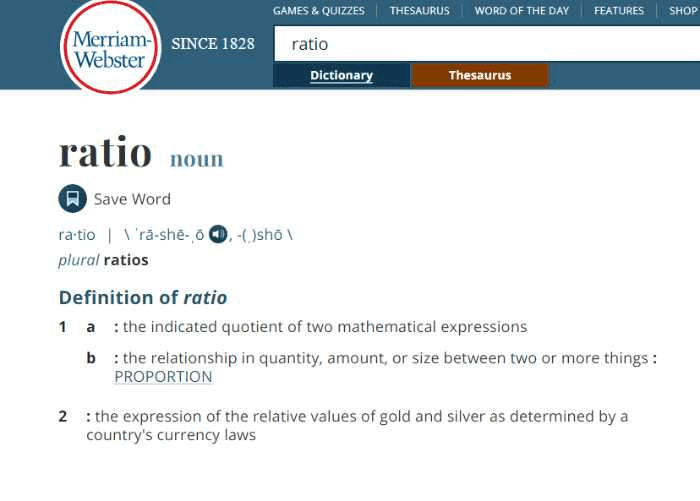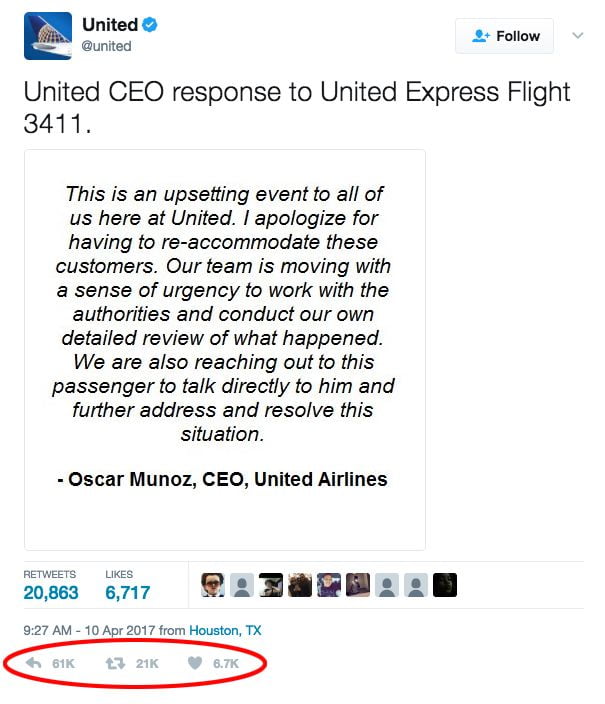We all already know that Twitter is one of the biggest traditional social media apps where users share short, 280-character messages called ‘tweets.’ One of the most important metrics on the app is the ratio – which is simply the number of likes or retweets a tweet has compared to the number of replies it received.
So what does ratio mean on Twitter?
If you get a lot more replies than likes or retweets, something may be off- especially if you’re committed to practicing good social media principles.
In this article, we will explain what the term ratio refers to on Twitter, what happens when you get ratioed, examples of Twitter users getting ratioed, and how you can avoid getting ratioed.
To help you better grasp the concept behind the term, let’s discuss what ‘ratio’ is not within Twitter’s context.
What ratio is not on Twitter
![]() In math, a ratio refers to the quantitative relation of two numbers. For example, if you have ten candy bars and twenty pieces of candy, your ratio would be 10:20 or 1:2. The number on the left (10) is the numerator, and the number on the right (20) is the denominator.
In math, a ratio refers to the quantitative relation of two numbers. For example, if you have ten candy bars and twenty pieces of candy, your ratio would be 10:20 or 1:2. The number on the left (10) is the numerator, and the number on the right (20) is the denominator.
In this particular case, the ratio would be telling you that for every ten candy bars you have, you also have twenty pieces of candy.
On the contrary, Twitter’s version of the word is not the same as the mathematical term we’ve come to learn in school. While it does have similarities in its essence, the term ratio, when taken in Twitter’s context, can mean a totally negative thing, far different from the mathematical term’s neutral definition.
This is the reason why the word ratio, when used in relation to Twitter, generally follows a negative connotation.
So what does ratio mean on Twitter’s platform?
What is ratio on Twitter
Ratio generally means two things on the social platform, and it can be somehow compared to Reddit’s karma system. Let’s look at what it means to ratio and to get ratioed on the app.
So what does it mean to ratio someone? To ratio someone is to go against the original post by replying to the original tweet and getting your reply more likes than the original. If a user successfully ratios someone with their reply to that particular post, this implies that the original tweet’s content is seen as less agreeable than the reply’s.
The term ratioed is also used to describe when a post has received more replies than likes and retweets. This can be due to the tweet containing controversial or divisive opinions that incite a negative response from users or simply because the post was purposefully made to agitate the public.
Tweets that have significantly more replies in the comments sections, compared to their likes and retweets, are ‘ratioed’ posts.
Posts that have a high ratio can experience an upsurge of negative replies. This kind of attention usually comes from backlash, bashing, or can simply be a result of a troll attack that can sometimes extend all the way to your direct messages.
So if your tweet gets ratioed, regardless if it occurred naturally or it happened to be targeted, that means your post is receiving large-scale, negative attention.
Since we’re breaking down the terminology, it also helps to turn to dictionaries. So what does ratio mean urban dictionary version?
What does ratio mean in Urban Dictionary?
Dictionaries are often seen as a source of authority when it comes to the English language. However, what many people don’t know is that dictionaries are not always in agreement about the meanings of words. In fact, there can be significant variation between different dictionaries when it comes to defining certain terms.
 This is particularly true for internet slang, which tends to change more rapidly than other aspects of language, especially with slang developed and standardized by the modern and younger generation. In Twitter’s context, the term ‘ratio’ is an example of this.
This is particularly true for internet slang, which tends to change more rapidly than other aspects of language, especially with slang developed and standardized by the modern and younger generation. In Twitter’s context, the term ‘ratio’ is an example of this.
 That’s why it’s not surprising that the Urban Dictionary definition of ‘ratio’ differs from traditional dictionary definitions. The Urban Dictionary definition is much more specific, referring specifically to the number of replies a tweet has received compared to likes or retweets.
That’s why it’s not surprising that the Urban Dictionary definition of ‘ratio’ differs from traditional dictionary definitions. The Urban Dictionary definition is much more specific, referring specifically to the number of replies a tweet has received compared to likes or retweets.
This modern definition is narrower and reflects how the term is used on the app, where a high number of replies can become a negative thing.
The term ratio, in Twitter’s context, however, is so widely used now that even non-urban dictionaries are taking notice. It has become so used that Merriam-Webster has included the terminology under its ‘Words We’re Watching’ status.
 Since every word is invented by humans, this shouldn’t really come as a surprise. Nevertheless, how dictionaries acknowledge terms are worth nothing.
Since every word is invented by humans, this shouldn’t really come as a surprise. Nevertheless, how dictionaries acknowledge terms are worth nothing.
We’ve dissected the terminology, but how did ratioing come about in social media?
The Changes that Helped Make ‘Twitter Ratio’ Happen
In 2016, Twitter made major changes to its social media platform. From how the timeline is displayed to what is displayed to the notifications you get down to the numbers that you see underneath every tweet—these changes, in a way, contributed to how ratioing developed.
Pre-2016, the platform used chronology in displaying tweets according to what users would find relevant. But when 2016 came, the chronological timeline was dropped and was replaced with an algorithm that displayed posts according to your retweets and likes, the people you follow, the engagements they have, and the popularity of a post.
To dig deeper into the kind of data you can get from Twitter, check out this guide on the best Twitter analytics tools.
 The change in algorithm and the data users see in every tweet has sparked the concept of ratioing. Because the algorithm now opens access to popular content, regardless if the account is followed or not, users can now jump in on any discussion as long as it is trending and active in real-time.
The change in algorithm and the data users see in every tweet has sparked the concept of ratioing. Because the algorithm now opens access to popular content, regardless if the account is followed or not, users can now jump in on any discussion as long as it is trending and active in real-time.
With the number of replies, retweets, and likes conveniently lined up under each tweet, users can get a quick glance of whether a certain post is actively engaged or not, even if they’re just scrolling through casually. If the tweet is set to public, spotting a ratioed post becomes a slice of cake.
Twitter has indeed become a more dynamic place because of the changes, but it also never runs out of drama, especially if we’re talking about ratios.
Let’s take a look at six examples of famous people getting ratioed on the app. This way, we can get a clearer understanding of how ratioing happens in reality.
6 Examples of the Biggest Ratio on Twitter
While Twitter is a great way to connect with friends and family, it can also be a place where users can get ratioed. What does that mean? And what happens when you get ratioed? Let’s look at examples of a few of the most popular real-life ratios on Twitter.
When someone gets ratioed, it means that their content has received more replies than likes. This generally happens when someone posts something controversial or unpopular. For instance, in January of 2019, Chick-fil-A CEO Dan Cathy made comments about gay marriage, which caused many people to reply to his tweet – but not many people liked it.
 Image from CNN article “Chick-fil-A president deletes anti-gay marriage tweet”
Image from CNN article “Chick-fil-A president deletes anti-gay marriage tweet”
As a result, Cathy got ratioed, leading him to delete his original commentary.
Another example of someone getting ratioed is Roseanne Barr. In May of 2018, she tweeted a racist remark which resulted in her show being canceled by ABC. Her post received more than 27,000 replies but only 1,400 likes.
 Image from PBS article “ABC cancels ‘Roseanne’ after comedian’s racist comment”
Image from PBS article “ABC cancels ‘Roseanne’ after comedian’s racist comment”
As you can see, Roseanne was definitely ratioed in that post.
Politics related, another instance of how a post gets ratioed is Sen. Chris McDaniel’s poll about how generals in the Confederacy should be remembered in history. The senator surveyed whether the public would remember the late Robert E. Lee as a ‘hero’ or a ‘villain.’
 After nearly 140,000 votes, almost 6,000 replies, and barely 3,000 likes, the voters made it pretty clear that a lot will remember the late confederate general as not a hero.
After nearly 140,000 votes, almost 6,000 replies, and barely 3,000 likes, the voters made it pretty clear that a lot will remember the late confederate general as not a hero.
Another example of a ratioed post, or probably one of the fastest ratioed posts ever, is from Washington Examiner Journalist Eddie Scarry. In the image below, Scarry is seen to be talking about Rep. Alexandria Ocasio-Cortez’s choice of clothing, implying that the coat she’s wearing doesn’t look like the kind of coat someone struggling would wear.
 Image from the CUT article “Here Are the Best Responses to That Tweet About Alexandria Ocasio-Cortez”
Image from the CUT article “Here Are the Best Responses to That Tweet About Alexandria Ocasio-Cortez”
After a couple of minutes—not even reaching its first hour—Scarry’s comments get flak from thousands of users. The total ratio of the post eventually turned out higher than the numbers seen in the photo. But by simply looking at the numbers, clearly, the attention the post is getting isn’t something to be lax about.
Here’s another instance. In a Newsweek article titled “Donald Trump Just Got One of His Worst Twitter Ratios Since Becoming President,” a post from Former US President Donald Trump is highlighted as one of his largely ratioed public commentaries on the social media platform. In this instance, the Former President is seen talking about how Russia ‘will be pushing very hard for the Democrats.’
 Image from Newsweek article “Donald Trump Just Got One of His Worst Ratios Since Becoming President”
Image from Newsweek article “Donald Trump Just Got One of His Worst Ratios Since Becoming President”
After he made the tweet in 2018, the former president received 46,000 replies and 44,000 likes. Three years later, he received a permanent ban from the platform after the social media giant cited two posts from his official account following the ‘January 6 US Capitol Riot’ that caused a number of deaths.
Lastly, here’s an example of how even a famous airline company isn’t safe from getting ratioed. In 2017, United Airlines’ security dragged a man off of a flight due to overbooking. How they handled the passenger—which was caught on camera—was upsetting, to say the least.
But what angered people, even more, was how United Airlines CEO Oscar Munoz ‘worded’ the incident on social media.
 Image from Esquire article title “How to Know If You’ve Sent a Horrible Tweet”
Image from Esquire article title “How to Know If You’ve Sent a Horrible Tweet”
Calling the incident a mere “re-accommodation” garnered ire from thousands of comments. The image of the actual post shows how huge the ratio is between the number of people liking the CEO’s apology and the number of those who have something to say about his response.
We saw how someone getting ratioed unfolds, but how does ratioing begin?
How Can People Ratio You?
How can a user ratio tweets? Aside from spotting the numbers, how can you tell if a particular post is getting ratioed? Is it easy to ratio someone?
Well, the answer to these questions is pretty straightforward.
When someone replies with “ratio” under a tweet, that means there is an intent to ratio the post. When you see someone replying with “ratio,” the user is trying to instigate negative attention. Consider it a call to action to target someone’s tweet.
 Image from the YouTube Channel Niramay Chugh
Image from the YouTube Channel Niramay Chugh
And this can be due to a number of reasons, such as if the tweet is controversial, if it’s insensitive, or if it’s just been posted at the wrong time. If you see that your post has gotten a lot of replies with the term, it might be a good idea to delete it and try again later.
See, spotting how ratioing begins is easy. Shaking off the effects of getting ratioed, however, is not. And once you start seeing the word “ratio” in your tweet’s reply section, deleting the tweet is practically the only way to put a pause on it (not like your other posts are any safe).
So, are there ways to evade a ratio?
Is there really a way to not get ratioed?
While it can be avoided, there is no 100% guarantee. People on the internet still have their individual makings. And that means different backgrounds, personalities, beliefs, and opinions. This is why it’s difficult to expect discussions to always remain on the same page with other users.
The platform is so open that it’s easy to come across strangers who won’t agree with you.
The social media channel isn’t always the easiest place to hang out for users who are very loose with their commentaries and can’t agree to disagree. And when you get ratioed, it can be even worse. The attention can be seriously tough to shake off.
Truth be told, even if you’re a responsible netizen on the platform, it can still be a tough place to share opinions regarding hot topics. So regardless of the intentions behind a tweet, you just have to be prepared for views that will differ.
But if you’re still worried about getting ratioed, what can you do to avoid it? Knowing what attracts ratioing can help you.
Knowing What Ratio on Twitter Means
The word ratio, in connection to the blue bird, is an urban word formed by users of the social media platform. It has a different meaning and connotation from the math terminology that has the same pronunciation and spelling.
Users who get ratioed are those whose tweets receive more replies than likes or retweets. For example, this can happen when a user posts something controversial, and their followers respond with disagreement or criticism.
Getting ratioed is not desirable; it means that your tweet was not well-received by most users who saw it. However, there are ways to avoid getting ratioed, such as avoiding posting content that will provoke adverse reactions from your followers.
If you do get ratioed, the best thing to do is acknowledge what has been done, what can be done, and the fact that you’ll never meet eye-to-eye with every single one on social media. Don’t reply to rt ratios.
FAQ’s about Twitter Ratio
What is the meaning of the term “ratio” on Twitter?
The term “ratio” on Twitter refers to the relationship between the number of replies to a tweet and the number of retweets or likes it receives. If a tweet has more replies than retweets or likes, it is said to have a high ratio, indicating that it has generated a lot of discussion and debate.
Why is the ratio important on Twitter?
The ratio is important on Twitter because it indicates the level of engagement a tweet has generated. A high ratio means that the tweet has sparked a lot of conversation and debate, while a low ratio suggests that the tweet has not resonated with the audience. This information can be useful for individuals and brands to gauge the impact of their tweets and to adjust their social media strategy accordingly.
How can you calculate the ratio of a tweet on Twitter?
To calculate the ratio of a tweet on Twitter, you can divide the number of replies by the number of retweets or likes. For example, if a tweet has 50 replies and 100 retweets, the ratio would be 0.5 or 50%. This indicates that the tweet has generated more replies than retweets, and therefore has a high ratio.
What are some strategies for improving your Twitter ratio?
Some strategies for improving your Twitter ratio include asking questions in your tweets to encourage engagement and discussion, responding to replies to show that you are listening to your audience, and participating in Twitter chats and other conversations relevant to your niche. You can also experiment with different types of content to see what resonates best with your audience.
Is the ratio the only metric to consider on Twitter?
No, the ratio is just one of many metrics to consider on Twitter. Other metrics to consider include the number of followers, the reach and impressions of your tweets, and the click-through rate of your links. It’s important to consider these metrics in conjunction with the ratio to get a complete picture of your Twitter performance and to optimize your social media strategy.

